World language help for learning differences
> Digital teaching sites
Access your bookmarks anywhere. MFL - Implementing the Group Talk Initiative and Other Strategies. KS2 Modern Foreign Languages - Introducing MFL into Schools Examing the issues of implementing Modern Foreign Languages Teachers TV Created: Fri Apr 28 03:08:30 BST 2006.
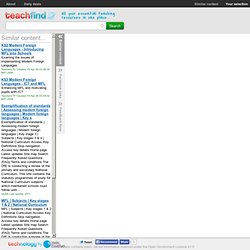
iPads: Not Just for Fun and Games. Although I teach honors algebra 2 as well as a low functioning Essential 1 freshman math class, I am striving to integrate iPads effectively in many ways beyond learning games for practicing computation and mathematical reasoning.
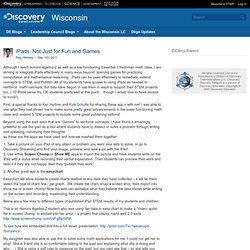
IPads can be used effectively to remediate, extend concepts to STEM, and Publish. All of my students have access to using iPads as needed to reinforce math concepts, but they have begun to use them in ways to support their STEM projects too, ( 10 iPads serve my 130 students pretty well at this point… though I would love to have access to more!).
Quest Visual showcases Word Lens. What are The Easiest Languages to Learn ?
Learning a new language has always been a hard task to do.
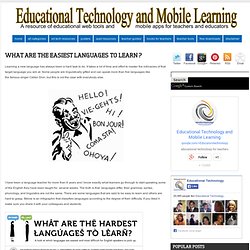
It takes a lot of time and effort to master the intricacies of that target language you aim at. Some people are linguistically gifted and can speak more than five languages like the famous singer Celien Dion, but this is not the case with everybody else.
Intricate Relationship.
Presentation station
Graham Davies's Favourite Websites. Search and Download International Terminology - Microsoft. ANGLAIS. Education Week Teacher Professional Development Sourcebook: ELL ‘Shadowing’ Shows Promise. Published Online: October 12, 2011 Published in Print: October 13, 2011, as ELL ‘Shadowing’ Shows Promise Having teachers experience “a day in the life of an English-language learner” can reveal gaps in academic-language exposure.
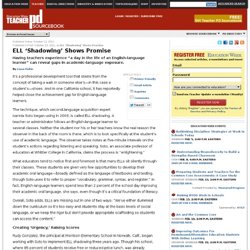
It’s a professional development tool that stems from the concept of taking a walk in someone else’s—in this case a student’s—shoes. And in one California school, it has reportedly helped close the achievement gap for English-language learners. The technique, which second-language acquisition expert Ivannia Soto began using in 2003, is called ELL shadowing. What educators tend to notice first and foremost is that many ELLs sit silently through their classes. Overall, Soto adds, ELLs are missing out in one of two ways: “We’ve either dummied down the curriculum so it’s too easy and students stay at the basic levels of social language, or we keep the rigor but don’t provide appropriate scaffolding so students can access the content.” Creating ‘Urgency,’ Raising Scores. At newcomer school, teachers step back to help students learn. Blendi Brahimaj, Wilis Hernandez and Reyson Rosario working together On a recent day at High School of Language and Innovation earth science teacher Katie Walraven did very little.
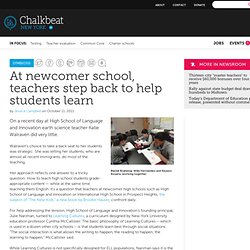
Walraven’s choice to take a back seat to her students was strategic: She was letting her students, who are almost all recent immigrants, do most of the teaching.
Phonetics: The Sounds of English and Spanish - The University of Iowa. Learning Chocolate. Assisting Students with Foreign Language Learning Difficulties in School. By: Leonore Ganschow and Elke Schneider (2006) The question of why some students seem to learn a foreign language with ease while others struggle has plagued both foreign language and special educators, especially in recent years.
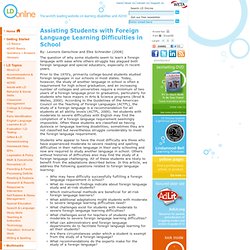
Prior to the 1970's, primarily college-bound students studied foreign languages in our schools in most states. Today, however, the study of another language in school is often a requirement for high school graduation, and an increasing number of colleges and universities require a minimum of two years of a foreign language prior to graduation, particularly for students who have majors in Arts & Science programs (Brod & Welles, 2000). According to the Guidelines of the American Council on the Teaching of Foreign Languages (ACTFL), the study of a foreign language is a recommendation for all students at all ability levels (ACTFL, 2000).
Assessment and Accommodations Research & Reports. Author: Baca, G.
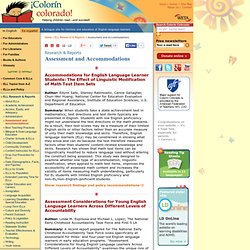
& Gandara, P. Springer Science Business and Media B.V. Summary: It is argued here that the combination of U.S. federal education policy as embodied in the No Child Left Behind Act of 2001 with the passage of a California state initiative that required that "nearly all classroom instruction [be]in English … for a period not normally intended to exceed one year" in 1998 created a "perfect storm" for English Learners. English Learners are thus provided inadequate and incomprehensible academic instruction.
Bilingual vs. ESL and Bilingual vs. Dual Language. Google + Teaching English to non-native speakers can be a complicated task, because different students have different levels of English language proficiency.
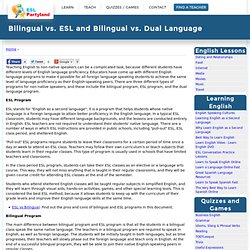
Educators have come up with different English language programs to make it possible for all foreign language speaking students to achieve the same level of language proficiency as their English-speaking peers. There are three different types of programs for non-native speakers, and these include the bilingual program, ESL program, and the dual language program. ESL Program. Chinese Flash Cards For Kids And Beginners. Learn English, Spanish, French, German, Italian, Portuguese.
Learn 40 Languages for Free with Free Audio Lessons. How to learn languages for free?
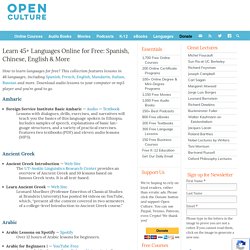
This collection features lessons in 48 languages, including Spanish, French, English, Mandarin, Italian, Russian and more. Download audio lessons to your computer or mp3 player and you’re good to go. Amharic Foreign Service Institute Basic Amharic – Audio – TextbookLessons with dialogues, drills, exercises, and narratives will teach you the basics of this language spoken in Ethiopia. Includes samples of speech, explanations of basic language structures, and a variety of practical exercises.
Italian Courses for Foreigners - Italian Culture and Language Courses in Rome - STUDIOITALIA. Learning Disabilities. A social group whose hands fly. "People were fading away," she said, community via the center's director, Donna Carlton.
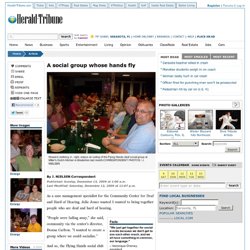
"I wanted to create a group where we could socialize.
" And so, the Flying Hands social club was formed. The group welcomes the deaf and hearing impaired and those who want to learn American Sign Language. "Flying Hands means hands fly when you sign," Jones said. "Deaf people, when they're together, their signing is very fast, it flows.
" The group's purpose is to motivate and get people involved, Carlton said. "Deaf people can be so isolated," Carlton said. The group's newly elected president is Veronique Cheney, who wrote on her laptop to communicate with a reporter.
Universities That Accept ASL In Fulfillment Of Foreign Language Requirements. See the new Notes section below for more specific information about schools, state acceptance of ASL as a foreign language, etc. If you have information about your school or state that you would like added to the Notes section, please contact me. 1. Abilene Christian University 2. American University 3. 4. 5. 6. 7. 8. 9. 10. 11. 12.
Sign Language Studies Up 16 Percent. American Sign Language Gains Popularity. Students with Dyslexia: ASL as a Foreign Language? Post #2 - I Speak of Dreams. Foreign Language Learning and Learning Disabilities. By: Sally S. Scott and Elaine Manglitz (1997) Making the college transition. Foreign Languages and Learning Disabilities -
If a child has dyslexia or any other learning disability, learning foreign language can seem like an impossibility!
Let me share with you our tricks and tips.
Workshop 7. You will see that the Reference Grid contains four columns. Look carefully at the headings. The first column contains general information about dyslexic learners. It describes learning difficulties which dyslexic learners commonly experience to a greater or lesser degree. Of course, all learners are different, so this Reference Grid deals only in generalities. A better grid would be one which described the characteristics of the particular learner who is causing you concern, but this will come later. Without information of sort contained in Column 1, it is impossible to differentiate effectively the tasks we plan to set, yet it is rare for this information to be readily available to subject teachers.
The second column takes each of the points covered in the first column and suggests what impact that particular characteristic is likely to have on the dyslexic learner's efforts to manage in the foreign anguage classroom. The last column has several functions.
Dyslexia. Section 504. It is our responsibility as educators to guarantee that our courses contain requirements that measure material taught and retained, not a student's disability. Schools with no clear policy on accommodation must face the issue and formulate coherent, fair, and legal policies.
These policies should be directed by the faculty, not legislated by the administration. Faculty members see the problem daily and are the curriculum experts in their fields. It is also imperative that foreign language instructors be educated in methods based on multiple modalities. An aurally impaired student, for example, would greatly benefit from a learning environment where a kinesthetic or haptic modality was used.
Appendix. Digests: Foreign Language Requirements And Students With Learning Disabilities. Resources. Learning Disabilities and Foreign Language Learning. By: Robin L.
Digests: Teaching Foreign Languages to At-Risk Learners. Resources.










